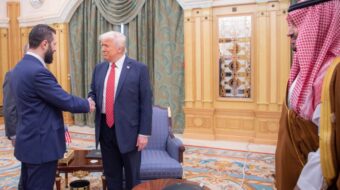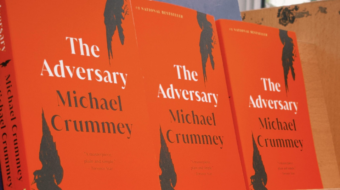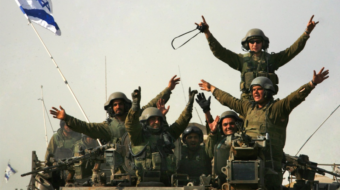
The Obama administration’s announcement last week that it would start direct military aid to Syrian rebels is a dangerous step in the wrong direction.
For over a year now, the U.S. has been helping reactionary Saudi Arabia and Qatar funnel money and weaponry to opposition groups in Syria, even though exactly who has been getting the money and arms is unclear.
Over the same time period, violence and bloodshed has steadily increased in Syria, with the death toll now over 90,000, and refugees flooding neighboring countries. There has been a surge in sectarian violence, much like the horrible militia violence that wracked Iraq during the U.S. occupation.
Inserting the U.S. more directly and adding more weaponry into this toxic mix is a recipe for disaster, in our view and that of many others.
In recent months, major news media have been filled with reports of chaotic divisions among Syria’s opposition forces, and the growing role of fanatical al-Qaeda-like Islamist groups. There have been reports of truly barbaric attacks by such elements, including, for example, a video of a rebel leader cutting out a government soldier’s heart and putting it in his mouth.
According to virtually every recent news report, the Syrian opposition has no clear leadership and is fractured among contending groups. It is not clear who, if any of them, represents the majority of Syria’s people.
In this context, the administration’s announcement that it plans to increase the “scale and scope” of its support to the so-called Syrian Opposition Coalition, including “direct support” (as opposed to channeling military aid through other countries like Qatar), is reckless indeed.
White House foreign policy advisor Benjamin Rhodes, who announced the new policy on Thursday, claimed that the administration was comfortable working with the opposition coalition. McClatchy reporter Hannah Allam called that “an odd assessment, given that U.S. officials told McClatchy only two weeks ago that the State Department was so fed up with the coalition’s lack of progress that it was considering diverting millions of dollars in U.S. funds earmarked for the group.” Another administration official said the coalition has “obviously been a very unstable organization.”
The White House claimed that it is ramping up intervention because it has determined that the Syrian government has used chemical weapons, crossing a “red line” that President Obama declared last fall. But experts say that evidence of chemical weapons use – by the government or by the rebels – is still unclear. The number of claimed victims of such chemical weapons is 130 to 150, a tiny number compared to the more than 90,000 dead in the fighting so far.
It appears that the chemical weapons issue is a pretext that the administration is using to escalate its military role. Commentators are pointing to several factors behind the administration’s move. These include:
* following recent military successes by the Assad regime, a fear that the Syrian rebellion could collapse. This would deal a blow to the U.S./UK/French desire to oust Assad and put in a moderate, West-friendly government that would be part of an alliance against Iran;
* the fear that collapse of the Syrian rebels would make the U.S. “look weak” on the world scene;
* pressure from conservative and liberal warhawks at home – most recently including Bill Clinton;
* interventionist pressure from Britain and France, former imperial powers in the Middle East. This is expected to be a big topic at this week’s G8 meeting in Northern Ireland;
* the “humanitarian intervention” policy that advocates military intervention with a human rights face as a way to advance U.S. geopolitical interests. This approach has gained ground with the appointment of Susan Rice as national security advisor and Samantha Power as ambassador to the United Nations.
The White House announcement did not specify what the ramped up U.S. intervention would consist of. According to Reuters, knowledgeable officials say the U.S. will provide automatic weapons, light mortars and rocket-propelled grenades, but not shoulder-fired surface-to-air missiles that could bring down Syrian military planes and helicopters. Also, these officials say, for now, the U.S. is not supporting setting up a “no-fly zone” over Syria, which would involve major U.S. and European military involvement to counter Syria’s extensive air defenses. For now?
Just last December President Obama achieved the final withdrawal of U.S. troops from Iraq, after our nine-year military debacle profoundly damaged and destabilized that country. It will take Iraq a long time to recover. Do we really want to unleash the ugly reactionary forces at play in Syria? Next door to Iraq, Syria occupies a central place in the Middle East – geographically, politically, historically, and culturally. For the U.S. to now directly insert itself militarily there, greatly increasing the chances for a disastrous outcome, is a profoundly bad move.
We urge our readers to contact the White House and congressional representatives and call for no military intervention of any kind in Syria. The only solution to the crisis there is through thoughtful diplomacy that places a priority on the wishes and interests of Syria’s democratic-minded people.
Photo: As the G8 meeting opened in Northern Ireland, with President Obama in attendance, Monday, June 17, members of Oxfam placed white roses and gravestones on the ground outside Belfast City Hall, symbolizing the bloodshed in Syria. Oxfam called on the G8 leaders to throw their weight behind a political solution to the conflict. (AP/Peter Morrison)










